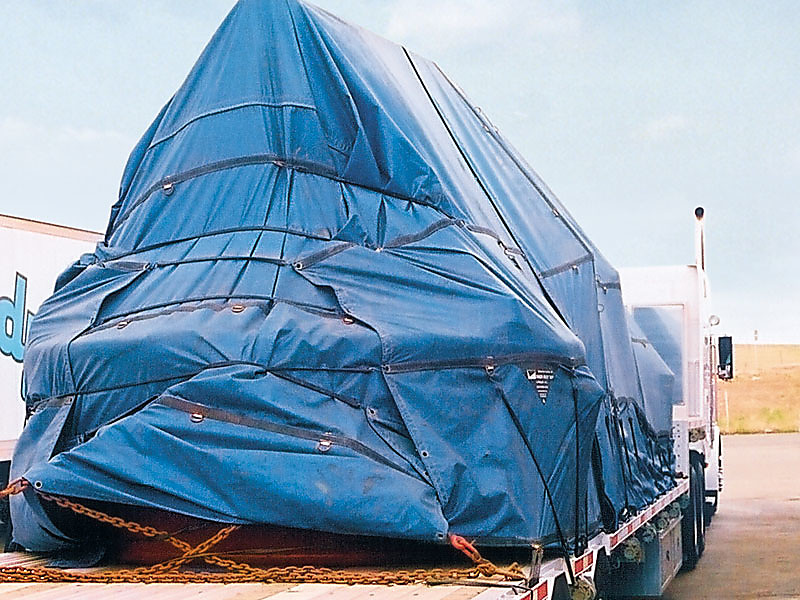Cold Crack to -40° C/F Cold Crack to -40° C/F Cold Crack to -40° C/F Cold Crack to -40° C/F Cold Crack to -40° C/F

In this blog post, we will be going over how to clean your flatbed tarp safely without the risk of damaging it in the process to make it look like it is in like-new condition. Before you begin you will want to check the manufacturer’s guidelines and recommendations for cleaning and maintaining your specific type of flatbed tarp as different materials may require unique care requirements. Let’s begin.

How to Clean Road Debris and Grime Off of Your Flatbed Tarps
Materials needed:
• (2) – Five Gallon Wash Buckets
• (1) – Wash Bucket Grit Gaurd to Remove Small Rocks (optional)
• (1) – Soft Car Wash Cleaning Brush (preferably with an extended handle)
• (1) – Car Wash Sponge or Car Wash Mitt
• (1) – Garden hose nozzle with different pressure options or optional pressure washer
• Mild Car Wash Soap of Choice (avoid bleach or harsh chemicals)
• Access to a source of clean water with a garden hose
Next, there are several options but we recommend placing the tarp in an area on either grass or pavement and spread out to make cleaning the tarp system easier. If you can avoid direct sunlight by placing the tarp in the shade during this process of cleaning your tarp that would be ideal to reduce heat from drying out the tarp quickly.
1). – Remove Loose Debris – Start by removing any loose debris along the flatbed tarp by either shaking off the debris or brushing away any visible debris with light pressure to remove any loose material along the tarp system.
2). – Hose Down the Tarp – Use a garden hose to apply low pressure to rinse down the tarp. Remove as much surface dirt, grime, dust, or other road debris as possible. You may use a pressure washer during this process but ensure that you are a far enough distance away and using light enough pressure to not cause damage to your tarp. This is why we strongly recommend using a garden hose to avoid any potential damage to your tarp system.
3). – Prepare Your Cleaning Solution – For the best results start by washing out your buckets to remove any grime or dust from storage. Once you have washed out the inside of the bucket(s) you can then fill the buckets around 70 to 75 percent of the way to the way full using warm water for the best results or room temperature water.
Next, add 2 to 4 ounces of mild soap solution to your bucket of water, and avoid using any harsh chemicals or bleach as they can cause damage to your flatbed tarps. We recommend using car wash soap or using a tarp-approved soap from the manufacturer of your tarp system.
Once you have added the soap to the water you will want to stir by hand or with your car wash brush for 15 to 20 seconds. Depending on the brand of soap you may need to adjust the mild soap mixture further by adding more soap. You will want to see at this point a lot of suds and bubbles.
4). – Start Spot Cleaning – For stubborn stains or localized dirt, use a soft brush or sponge dipped in the cleaning solution to spot-clean the affected areas. Certain areas of the tarp system may require you to do several wash cycles to remove stubborn grime and dirt. Just be mindful of the amount of pressure you apply as you do not want to damage your tarp.
5). – Scrubbing the Flatbed Tarp – Gently scrub the entire tarp with a soft brush or sponge soaked in the cleaning solution. Work in sections to ensure thorough cleaning and to ensure that you aren’t missing areas of your tarp. You may need to create more soap solutions as you work around the tarp system.

6). – Rinse Thoroughly – Use the garden hose or pressure washer to rinse off the tarp thoroughly to remove all of the soap residue. This may take some time and while you are rinsing off the tarp look for areas that you may have missed or may need further attention to detail to remove the dirt or grime.
7). – Allow the Flatbed Tarp to Air Dry – Once the tarp has been washed thoroughly you will want to ensure that the flatbed tarp is entirely dry. You should allow the tarp to sit in a dry area away from the initial washing area as it may still be damp around the tarp and slow the drying time. As the tarp dries make sure to look for any damage along the tarp as now that the tarp system is clean you will be able to inspect the tarp for damage much more easily.
8). – How to Properly Store the Flatbed Tarp – Once you have completely washed the tarp, removed the debris, and allowed the tarp system to air dry you should now think about proper storage techniques. Store the tarp in a cool, dry place, and avoid folding it when possible when storing it for extended periods to prevent creases and potential damage.
To get the best results out of your flatbed tarp you should perform regular maintenance by keeping the tarp clean and inspecting the flatbed tarp for any issues. If you do spot any tears or damage to the tarp you will want to address these as soon as possible to prevent further deterioration or added damage to your flatbed tarp.

How to Remove Mold and Mildew from Your Flatbed Tarps
Materials Needed:
• (1) – Soft Brush or Sponge
• (1) – Spray Bottle
• Cleaning Solution of choice either store-bought or made at home.
• Garden Hose
• Garden Hose Nozzle or Pressure Washer
• Protective PPE such as gloves and a mask to prevent inhalation of mold spores
1). – Brush Off Loose Mold – Start by using the soft brush or broom to gently brush off any loose surface mold away from the tarp. This will help you prevent the mold spores from spreading when treating the mold on the flatbed tarp.
2). – Prepare A Cleaning Solution – This step is going to be dependent on how you would like to approach this. If you don’t feel comfortable creating your cleaning solution or have the materials at hand consider purchasing a safe-to-use tarp cleaner in a store. If you wish to create your own tarp cleaning solution you can use a mixture of white vinegar and water (1 part vinegar to 3 parts water) or a solution of hydrogen peroxide and water (1 part hydrogen peroxide to 5 parts water).
Note: Always test any cleaning solution on a small test spot before applying it to the rest of the tarp to ensure that the product does not cause damage to your tarp. Tarps can be made of several different types of materials so it’s important to test the cleaner on a small spot before doing the whole tarp. You should also wear protective gear such as gloves and a mask when cleaning the mold to avoid inhaling any spores.
3). – Apply the Tarp Cleaning Solution – Dip a soft brush or sponge into the cleaning solution and gently scrub the moldy areas of the tarp. This step may need to be repeated depending on how long or large the mold or mildew exposure is on the flatbed tarp. After the solution has been applied allow the solution to sit for 10-15 minutes for the best results. The cleaning solution needs time to penetrate the mold and break it down.
4). – Scrub, Scrub, Scrub – Once you have given the cleaning solution time to clean and penetrate the mold now begin to scrub the areas with mold or mildew. You may need to repeat this process several times but start by using light-pressure and work your way up as needed to prevent damage to the tarp.
5). – Rinse Thoroughly – Rinse the flatbed tarp thoroughly with clean water to remove any leftover cleaning solution residue and to ensure you have removed all of the mold spores from the tarp. You may need to repeat this process several times to have the best results for areas that are heavily molded.
6). – Dry Completely – Allow the tarp to fully dry in the sun or a well-ventilated area to prevent the tarp from receiving any new mold or mildew. Sunlight helps to reduce the chance of mold growth so if possible keep the tarp out in the sunlight to ensure the tarp is fully dry. Before you put the tarp into storage you may also want to apply a mold treatment to prevent future mold growth by using a mold inhibitor or use a waterproof spray coating designed to reduce mold and mildew.
If the mold problem is severe or if the tarp is already in poor condition you may want to consider replacing the tarp for the best long-term results. Luckily, we have a full selection of Flatbed Tarps if you need to purchase a reputable and high-quality flatbed lumber tarp or flatbed steel tarp.

Shop our Popular Flatbed Tarps
18 oz Coated Fabric
18 oz Coated Fabric
18 oz Coated Fabric
18 oz Coated Fabric
18 oz Coated Fabric
How to Clean Flatbed Tarps Safely from Mold and Debris
Published on 02/27/24
1115403
$289.00
1115402
$289.00
1115493
$374.00
1115462
$370.00
1115463
$370.00











